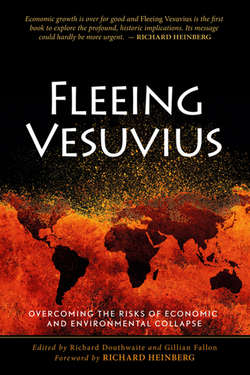Читать книгу Fleeing Vesuvius - Gillian Fallon - Страница 12
На сайте Литреса книга снята с продажи.
ОглавлениеCalculating the Energy Internal Rate of Return
TOM KONRAD
With a constant technology mix, EROI is the most important number because you will always be making new energy investments as old investments outlive their useful lives and are decommissioned. However, in a period of transition such as the one we are entering, we need a quick return on our energy investments in order to maintain our society. We have to have energy to invest; we can’t simply charge it to our energy credit card and repay it later. That means that if we’re going to keep the non-energy economy going while we make the transition, we can’t put too much energy today into the long-lived energy investments we’ll use tomorrow.
To give a clearer picture of how timing of energy flows interacts with EROI, I will borrow the Internal Rate of Return (IRR) concept from finance. IRRs compare different investments with radically different cash-flow timings by assigning each a rate of return that could produce those cash flows if the money invested were compounded continuously. Except in special circumstances involving complex or radically different sized cash flows, an investor will prefer an investment with a higher IRR.
To convert an EROI into an Energy Internal Rate of Return, EIRR, we need to know the lifetime of the installation and what percentage of the energy cost is fuel, compared to the percentage of the energy embodied in the plant. The chart below shows my preliminary calculations for EIRR, along with the plant lifetimes I used, and the EROI shows as the size of each bubble.
The most valuable energy resources are those with large bubbles (High EROI) at the top of the chart (High EIRR). Because of the low EIRR of photovoltaic, nuclear and hydropower, emphasizing these technologies in the early stage of the transition away from fossil fuels is likely to lead to a scenario in which we don’t have enough surplus energy, to make the transition without massive disruption to the rest of the economy. Jeff Vail, the author of The Theory of Power (see jeffvail.net) refers to this front-loading of energy investment for renewable energy and nuclear as the Renewables Hump. Note that the three fossil fuels (oil, gas, and coal) all have high EIRRs. As we transition to lower-carbon fuels, we will want to keep as many high EIRR fuels in our portfolio as possible.
How quickly do we earn back the energy we invest?
Average data from literature review
PV = Photovoltaic, CSP = Concentrated Solar Power
CCS = Carbon Capture and Sequestration
THE AREA of each bubble represents the energy return on energy invested — EROI. The most valuable energy resources are those with large bubbles — a high EROI — at the top of the chart because this shows that they also have a high Energy Internal Rate of Return — EIRR. In other words, they pay back the energy invested in developing them rather quickly. Photovoltaic, nuclear and hydropower have low rates of energy return. Graph compiled and redrawn specially for Feasta by Jamie Bull, oco-carbon.com
Energy Efficiency and “Smart” Strategies
I have been unable to find studies of the EROI of various efficiency technologies. For instance, how much energy is embodied in insulation, and how does that compare to the energy saved? We can save transportation fuel with “smart” strategies such as living in more densely populated areas that are closer to where we work, and investing in mass transit infrastructure. The embodied energy of mass transit can be quite high in the case of light rail, or it can be very low in the case of better scheduling and incentives for ride sharing.
Many efficiency and smart technologies and methods are likely to have much higher EIRRs than fossil fuels. We can see this because, while their embodied energy has not been well studied, their financial returns have. Typical investments in energy efficiency in utility run demand-side management programmes cost between $0.01 and $0.03 cents per kWh saved, much less than the cost of new fossil-fired generation. This implies a higher EIRR for energy efficiency, because part of the cost of any energy-efficiency measure will be the cost of the embodied energy, while all of the savings are in the form or energy. This relationship implies that higher IRR technologies will generally have higher EIRRs as well. Smart strategies also often show extremely high financial returns because they reduce the need for expensive cars, roads, parking, and even accidents. See vtpi.org/winwin.pdf.
Brain Rather than Brawn
The Renewables Hump does not have to be the massive problem it seems when we only look at supply-side energy technologies. Demand-side solutions, such as energy efficiency, conservation and better public transport, enable us to avoid running into a situation where the energy we have to invest in transitioning from finite and dirty fossil fuels to clean renewable energy overwhelms our current supplies.
Efficiency and smart strategies are “Brain” technologies, as opposed to the “Brawn” of traditional and new energy sources. As such, their application requires long-term planning and thought. Cheap energy has created a culture where we prefer to solve problems by simply applying more brawn. As our fossil-fuel brawn fades away, we will have to rely on our brains once again if we hope to maintain anything like our current level of economic activity.
